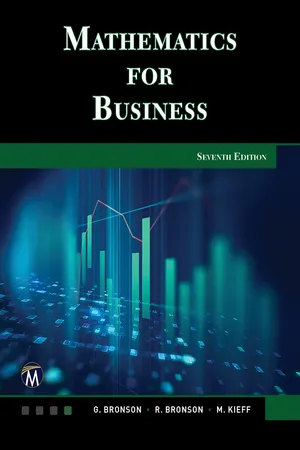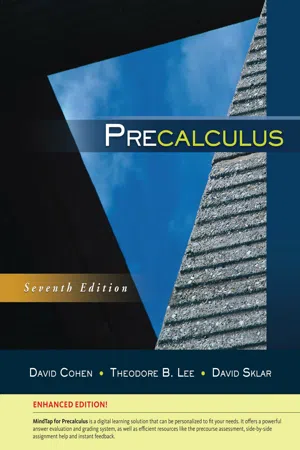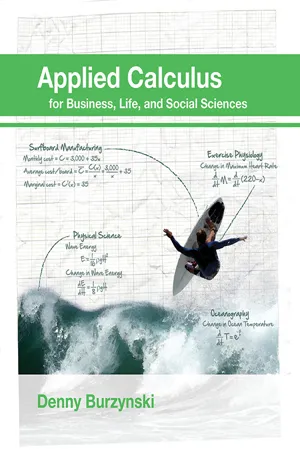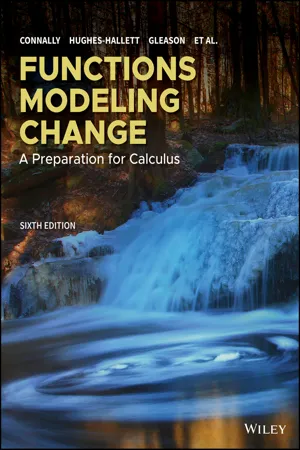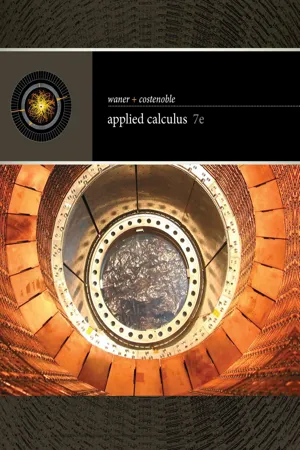Mathematics
Average Rate of Change
The average rate of change measures the average amount of change in a quantity over a specific interval. It is calculated by finding the difference in the values of the quantity at the endpoints of the interval and dividing by the length of the interval. In mathematics, it is commonly used to analyze the average speed or average growth rate of a function.
Written by Perlego with AI-assistance
Related key terms
1 of 5
11 Key excerpts on "Average Rate of Change"
- No longer available |Learn more
- Gary Bronson, Richard Bronson, Maureen Kieff(Authors)
- 2021(Publication Date)
- Mercury Learning and Information(Publisher)
We reserve our study of these applications, however, until Chapter 6. In this chapter, we direct our attention to the derivative as a rate of change and providing specific rules for calculating derivatives of commonly encountered mathematical functions. 5.1 AVERAGE RATES OF CHANGE An extremely useful measure in business forecasting is the average rate at which a quantity changes. For example, it is useful in predicting sales for the month of April to know that sales in March totaled 10,000 units. Even more useful, however, is the additional information that sales have been increasing, on average, at a rate of 2,000 units per month. Similarly, a company needs information on wage scales for the past year before it can prepare next year’s budget. In addition, however, information on the average yearly increase in salaries is also important. In both these situations knowledge of the rates that quantities change, either changes in sales per month or changes in wages paid per hour, increases one’s ability to forecast future requirements accurately. One rate of change you are probably familiar with is average speed, which measures the change in distance for a given change in time. For example, if an individual traveled 500 miles in 10 hours, the average change in distance with respect to time is 50 miles per hour. That is, on the average, each hourly increase in driving time resulted in an increase of 50 miles traveled. Formally, this average speed is calculated by dividing the total change in miles driven by the total change in hours traveled using the formula: Example 1: A woman drove from her house to a destination 400 miles away. The following table shows how far she traveled at 1 hour intervals - eBook - PDF
- David Cohen, Theodore Lee, David Sklar, , David Cohen, Theodore Lee, David Sklar(Authors)
- 2016(Publication Date)
- Cengage Learning EMEA(Publisher)
All Rights Reserved. May not be copied, scanned, or duplicated, in whole or in part. Due to electronic rights, some third party content may be suppressed from the eBook and/or eChapter(s). Editorial review has deemed that any suppressed content does not materially affect the overall learning experience. Cengage Learning reserves the right to remove additional content at any time if subsequent rights restrictions require it. For an example using the Average Rate of Change in a different context, consider the function s represented in Figure 7, with defining equation s ( t ) 16 t 2 , and t 0. This function relates the distance s ( t ) and the time t for an object falling in a vacuum. Here t is measured in seconds, s ( t ) is in feet, and t 0 corresponds to the instant that the object begins to fall. For instance, after 1 sec, the object falls a distance of s (1) 16(1) 2 16 ft. After 2 sec, the total distance will be s (2) 16(2) 2 64 ft. Let’s calculate the Average Rate of Change of this function from, say, t 1 to t 3 sec. As in the temperature example, we’ll keep track of the units. We have Notice that the units here have the form distance per unit time. So in this case ¢ s ¢ t gives us the average velocity of the object. More generally, whenever we have a func-tion expressing distance s ( t ) in terms of time t , the average velocity over an interval is defined to be the Average Rate of Change ¢ s ¢ t over that interval. We’ll return to this idea in Example 6 at the end of this section. Let’s talk for a moment about notation. We defined the Average Rate of Change of a function f on the interval [ a , b ] to be the quantity (1) If, instead of [ a , b ], we have the interval [ a , x ], then, by definition, the Average Rate of Change is (2) Finally, if the interval is [ x , x h ] as displayed in Figure 8, then the Average Rate of Change is which simplifies to (3) Each of the algebraic expressions given in (1), (2), or (3) is known as a difference quotient. - eBook - PDF
Applied Calculus
for Business, Life, and Social Sciences
- Denny Burzynski(Author)
- 2014(Publication Date)
- XYZ Textbooks(Publisher)
44 Chapter 1 Functions, Limits, and Rates of Change Solution To find the Average Rate of Change in the surface area from r = 1 to r = 3, we find the slope of the line that passes through the points (1, S(1)) and (3, S(3)). Average Rate of Change = S(3) − S(1) __________ 3 − 1 = 4π . 3 2 − 4π . 1 2 _____________ 3 − 1 = 36π − 4π ________ 2 = 16π in 2 /in The surface area of the balloon increases an aver- age of 16π in 2 /in as the radius increases from 1 inch to 3 inches. Note that this is one situation in which reducing the units to in 2 /in = in makes the result less understandable. Difference Quotients and Average Rate of Change We can generalize the Average Rate of Change of any function, and, at the same time, begin our work with a formula that is important in calculus. In the diagram below, the slope of the blue line (called a secant line) is the Average Rate of Change of the red curve from point P to point Q. The slope of the line passing through the points P and Q is given by the following formula: Slope of line through P and Q = m = f (b ) − f (a) __________ b − a The expression f (b) − f (a) ______ b − a is called a difference quotient. It represents the Average Rate of Change of the function f from the point (a, f (a)) to the point (b, f (b)). Throughout your study of calculus, you will see the difference quotient in a variety of forms. For instance, Example 8 uses the points (x 1 , y 1 ) and (x 2 , y 2 ) rather than (a, f (a)) and (b, f (b)). Either way, the difference quotient represents the slope of the secant line and the Average Rate of Change between those points. Figure 6 r S(r) 100 50 150 200 1 2 3 4 S (3) - S(1) 3 - 1 Figure 7 x y y = f (x) P Q Run = b - a Rise = f (b) - f (a) a x f (b) f (a) b - a Rise Run m = Note A line that passes through two points on a graph is called a secant line. We will see much more of these lines in Section 1.6. - eBook - PDF
- Deborah Hughes-Hallett, Patti Frazer Lock, Andrew M. Gleason, Daniel E. Flath, Sheldon P. Gordon, David O. Lomen, David Lovelock, William G. McCallum, Brad G. Osgood, Andrew Pasquale, Jeff Tecosky-Feldman, Joseph Thrash, Karen R. Rhea, Thomas W. Tucker(Authors)
- 2018(Publication Date)
- Wiley(Publisher)
We mimic what we did for velocity and look at the Average Rate of Change over smaller and smaller intervals. The instantaneous rate of change of at , also called the rate of change of at , is defined to be the limit of the average rates of change of over shorter and shorter intervals around . Since the Average Rate of Change is a difference quotient of the form Δ∕Δ, the instantaneous rate of change is a limit of difference quotients. In practice, we often approximate a rate of change by one of these difference quotients. Example 1 The quantity (in mg) of a drug in the blood at time (in minutes) is given by = 25(0.8) . Estimate the rate of change of the quantity at = 3 and interpret your answer. Solution We estimate the rate of change at = 3 by computing the Average Rate of Change over intervals near = 3. We can make our estimate as accurate as we like by choosing our intervals small enough. Let’s look at the Average Rate of Change over the interval 3 ≤ ≤ 3.01: Average Rate of Change = Δ Δ = 25(0.8) 3.01 − 25(0.8) 3 3.01 − 3.00 = 12.7715 − 12.80 3.01 − 3.00 = −2.85. A reasonable estimate for the rate of change of the quantity at = 3 is −2.85. Since is in mg and in minutes, the units of Δ∕Δ are mg/minute. Since the rate of change is negative, the quantity of the drug is decreasing. After 3 minutes, the quantity of the drug in the body is decreasing at 2.85 mg/minute. In Example 1, we estimated the rate of change using an interval to the right of the point ( = 3 to = 3.01). In the next section we briefly consider other ways of making estimates. The Derivative at a Point The instantaneous rate of change of a function at a point is so important that it is given its own name, the derivative of at , denoted () (read “ -prime of a”). If we want to emphasize that - eBook - PDF
- Linda Almgren Kime, Judith Clark, Beverly K. Michael(Authors)
- 2018(Publication Date)
- Wiley(Publisher)
Bureau of the Census. 72 CHAPTER 2 Rates of Change and Linear Functions Number of U.S. Newspapers Year Newspapers (thousands of copies printed) Number of Newspapers Published 1920 27,791 2042 1930 39,589 1942 1940 41,132 1878 1950 53,829 1772 1960 58,882 1763 1970 62,108 1748 1980 62,202 1745 1990 62,324 1611 2000 55,800 1480 2008 48,598 1408 Source: U.S. Bureau of the Census. Number of U.S. Commercial TV Stations Year Number of Commercial TV Stations 1950 98 1960 515 1970 677 1980 734 1990 1092 2000 1248 2008 1353 Source: U.S. Bureau of the Census. 2.3 The Average Rate of Change Is a Slope On a graph, the Average Rate of Change is the slope of the line connecting two points. The slope is an indicator of the steepness of the line. Calculating Slopes If (x 1 , y 1 ) and (x 2 , y 2 ) are two points, then the change in y equals y 2 − y 1 . This difference is often denoted by Dy, read as “delta y,” where D is the Greek letter capital D (think of D as representing difference): Dy = y 2 − y 1 . Similarly, the change in x (delta x) can be represented by Dx = x 2 − x 1 . See Figure 2.8. The reading “Slopes” describes many of the practical applications of slopes, from cowboy boots to handicap ramps. Reading The Average Rate of Change represents a slope. Given two points (x 1 , y 1 ) and (x 2 , y 2 ), = = D D = − − = y x y x y y x x Average Rate of Change change in change in slope 2 1 2 1 (x 2 , y 2 ) (x 2 , y 1 ) (x 1 , y 1 ) Dy = y 2 – y 1 Dx = x 2 – x 1 x y FIGURE 2.8 Slope = Dy/ D x 2.3 The Average Rate of Change Is a Slope 73 When calculating a slope, it doesn’t matter which point is first Given two points, (x 1 , y 1 ) and (x 2 , y 2 ), it doesn’t matter which one we use as the first point when we calculate the slope. In other words, we can calculate the slope between (x 1 , y 1 ) and (x 2 , y 2 ) as y y x x y y x x or as 2 1 2 1 1 2 1 2 − − − − The two calculations result in the same value. - eBook - PDF
- James Stewart, Lothar Redlin, Saleem Watson, , James Stewart, Lothar Redlin, Saleem Watson(Authors)
- 2015(Publication Date)
- Cengage Learning EMEA(Publisher)
(You are asked to prove these facts in Exer-cises 51 and 52 in Section 2.5.) In general, the Average Rate of Change of a linear func-tion between any two points is the constant m . In the next example we find the Average Rate of Change for a particular linear function. EXAMPLE 4 ■ Linear Functions Have Constant Rate of Change Let f 1 x 2 3 x 5 . Find the Average Rate of Change of f between the following points. (a) x 0 and x 1 (b) x 3 and x 7 (c) x a and x a h What conclusion can you draw from your answers? SOLUTION (a) Average Rate of Change f 1 1 2 f 1 0 2 1 0 1 3 # 1 5 2 1 3 # 0 5 2 1 1 2 2 1 5 2 1 3 (b) Average Rate of Change f 1 7 2 f 1 3 2 7 3 1 3 # 7 5 2 1 3 # 3 5 2 4 16 4 4 3 (c) Average Rate of Change f 1 a h 2 f 1 a 2 1 a h 2 a 3 3 1 a h 2 5 4 3 3 a 5 4 h 3 a 3 h 5 3 a 5 h 3 h h 3 It appears that the Average Rate of Change is always 3 for this function. In fact, part (c) proves that the rate of change between any two arbitrary points x a and x a h is 3. Now Try Exercise 25 ■ CONCEPTS 1. If you travel 100 miles in two hours, then your average speed for the trip is average speed 2. The Average Rate of Change of a function f between x a and x b is Average Rate of Change 3. The Average Rate of Change of the function f 1 x 2 x 2 between x 1 and x 5 is Average Rate of Change 4. (a) The Average Rate of Change of a function f between x a and x b is the slope of the line between 1 a , f 1 a 22 and 1 b , f 1 b 22 . (b) The Average Rate of Change of the linear function f 1 x 2 3 x 5 between any two points is . 2.4 EXERCISES Copyright 2016 Cengage Learning. All Rights Reserved. May not be copied, scanned, or duplicated, in whole or in part. Due to electronic rights, some third party content may be suppressed from the eBook and/or eChapter(s). - eBook - PDF
A Course of Mathematical Analysis
International Series of Monographs on Pure and Applied Mathematics
- A. F. Bermant, I. N. Sneddon, S. Ulam, M. Stark(Authors)
- 2016(Publication Date)
- Pergamon(Publisher)
If the function y = f(x) is not linear, then Ay = f{x + Ax)-f(x) Ax ~ Ax depends both on x and A x. But this ratio characterizes the function on the average (in the usual sense) when the independent variable changes from x to x + A x; it is the rate of change of the linear function which has the same increment Ay in the same interval (x, x + Ax). Definition. The ratio Ay/Δχ is called the Average Rate of Change v av of the function in the interval (AC, X + Δ x)· We now reflect that the Average Rate of Change characterizes the function better and better as the length of the interval Ax di-minishes (i.e. as we get closer and closer to the point x). This reflection is based on the following obvious fact: different graphs of func-tions y = f(x), passing through two points A(x, y) and B(x + Ay, y + Ay) (see Fig. 52), differ less and less, in general, between these points from the straight line AB, the smaller AB becomes. In view of this, we let A x tend to zero and consider the behaviour in the limit of the Average Rate of Change of the function. If the limit exists, it is taken as a measure of the speed or r a t e of change of the function for the given x and is called the rate of change of the func-tion. Definition. The rate of change v of the function y = f(x) for a given x (at a given point x) is defined as the limit (if it exists) of the Average Rate of Change v av = Ay/A χ of the function in the interval (Ä, x + Ax) as Ax tends to zero: Λ , Λ ,. f( x + Ax) —f(x) v = lim v av = lim Ay/A x = lim — — ■ — -r^ — J -±-t. j*->o jx-+o J*->O AX Using the new terminology, we can say that: (1) velocity is the rate of change of distance as a function of time; (2) linear density is the rate of change of mass as a function of length; (3) specific heat is the rate of change of the amount of heat as a function of temperature. - eBook - PDF
Functions Modeling Change
A Preparation for Calculus
- Eric Connally, Deborah Hughes-Hallett, Andrew M. Gleason(Authors)
- 2019(Publication Date)
- Wiley(Publisher)
We now calculate average rates of change for functions given by formulas. Example 4 Calculate the average rates of change of the function () = 2 between = 1 and = 3 and between = −2 and = 1. Show your results on a graph. Solution Between = 1 and = 3, we have Average Rate of Change of () over the interval 1 ≤ ≤ 3 = Change in () Change in = (3) − (1) 3 − 1 = 3 2 − 1 2 3 − 1 = 9 − 1 2 = 4. 14 Chapter 1 LINEAR FUNCTIONS AND CHANGE Between = −2 and = 1, we have Average Rate of Change of () over the interval −2 ≤ ≤ 1 = Change in () Change in = (1) − (−2) 1 − (−2) = 1 2 − (−2) 2 1 − (−2) = 1 − 4 3 = −1. The Average Rate of Change between = 1 and = 3 is positive because () is increasing on this interval. See Figure 1.15. However, on the interval from = −2 and = 1, the function is partly decreasing and partly increasing. The Average Rate of Change on this interval is negative because the decrease on the interval is larger than the increase. (−2, 4) (1, 1) (3, 9) () = 2 ✒ Slope = −1 ✛ Slope = 4 Figure 1.15: Average Rate of Change of () on an interval is the slope of the dashed line on that interval Summary for Section 1.2 • Average Rate of Change of = () on ≤ ≤ is Δ Δ = () − () − . Average Rate of Change can be visualized as the slope of the line between the points on the graph of from = to = . • Increasing functions have positive average rates of change; decreasing functions have negative average rates of change. Exercises and Problems for Section 1.2 Skill Refresher In Exercises S1–S10, simplify each expression. S1. 4 − 6 3 − 2 S2. 1 − 3 2 2 − (−3) 2 S3. −3 − (−9) −1 − 2 S4. (1 − 3 2 ) − (1 − 4 2 ) 3 − 4 S5. 1 2 − (−4) 2 − ( 1 2 − (5 2 ) ) −4 − 5 S6. 2( + ) − 3( − ) S7. 2 − (2 + ) 2 S8. 4 2 − ( − ) 2 S9. 2 − 3 4 − ( 2 − 3 4 ) − S10. 2( + ℎ) 2 − 2 2 ( + ℎ) − S11. - eBook - PDF
- Stefan Waner, Steven Costenoble(Authors)
- 2017(Publication Date)
- Cengage Learning EMEA(Publisher)
Leibniz d Notation We introduced the notation f r 1 x 2 for the derivative of f at x, but there is another interesting notation. We have written the Average Rate of Change as Average Rate of Change 5 D f D x . Change in f Change in x As we use smaller and smaller values for D x, we approach the instantaneous rate of change, or derivative, for which we also have the notation df> dx, due to Leibniz: Instantaneous rate of change 5 lim D x S0 D f D x 5 df dx . That is, df> dx is just another notation for f r 1 x 2 . Do not think of df> dx as an actual quotient of two numbers: Remember that we use an actual quotient D f> D x only to approximate the value of df> dx. In Example 3 we apply the quick approximation method of estimating the derivative. Velocity My friend Eric, an enthusiastic baseball player, claims that he can “probably” throw a ball upward at a speed of 100 feet per second 1 ft/sec 2 . ✱ Our physicist friends tell us that its height s (in feet) t seconds later would be s 5 100t 2 16t 2 . Find its average velocity over the interval 3 2, 3 4 and its instantaneous velocity exactly 2 seconds after Eric throws it. Solution The graph of the ball’s height as a function of time is shown in Figure 34. Asking for the velocity is really asking for the rate of change of height with respect to time. (Why?) Consider average velocity first. To compute the average velocity of the ball from time 2 to time 3, we first compute the change in height: Ds 5 s 1 3 2 2 s 1 2 2 5 156 2 136 5 20 feet. Since it rises 20 feet in Dt 5 1 second, we use the defining formula speed 5 distance> time to get the average velocity: Average velocity 5 Ds Dt 5 20 1 5 20 ft/sec from time t 5 2 to t 5 3. This is just the difference quotient, so we have the following: The average velocity is the Average Rate of Change of height. To get the instantaneous velocity at t 5 2, we find the instantaneous rate of change of height. In other words, we need to calculate the derivative ds> dt at t 5 2. - eBook - PDF
- Stefan Waner, Steven Costenoble(Authors)
- 2017(Publication Date)
- Cengage Learning EMEA(Publisher)
Leibniz d Notation We introduced the notation f r 1 x 2 for the derivative of f at x , but there is another interesting notation. We have written the Average Rate of Change as Average Rate of Change 5 D f D x . Change in f Change in x As we use smaller and smaller values for D x , we approach the instantaneous rate of change, or derivative, for which we also have the notation df > dx , due to Leibniz: Instantaneous rate of change 5 lim D x S 0 D f D x 5 df dx . That is, df > dx is just another notation for f r 1 x 2 . Do not think of df > dx as an actual quotient of two numbers: Remember that we use an actual quotient D f > D x only to approximate the value of df > dx . In Example 3 we apply the quick approximation method of estimating the derivative. Velocity My friend Eric, an enthusiastic baseball player, claims that he can “probably” throw a ball upward at a speed of 100 feet per second 1 ft/sec 2 . ✱ Our physicist friends tell us that its height s (in feet) t seconds later would be s 5 100 t 2 16 t 2 . Find its average velocity over the interval 3 2, 3 4 and its instantaneous velocity exactly 2 seconds after Eric throws it. Solution The graph of the ball’s height as a function of time is shown in Figure 34. Asking for the velocity is really asking for the rate of change of height with respect to time. (Why?) Consider average velocity first. To compute the average velocity of the ball from time 2 to time 3, we first compute the change in height: D s 5 s 1 3 2 2 s 1 2 2 5 156 2 136 5 20 feet . Since it rises 20 feet in D t 5 1 second, we use the defining formula speed 5 distance > time to get the average velocity: Average velocity 5 D s D t 5 20 1 5 20 ft/sec from time t 5 2 to t 5 3 . This is just the difference quotient, so we have the following: The average velocity is the Average Rate of Change of height. To get the instantaneous velocity at t 5 2 , we find the instantaneous rate of change of height. - Ronald Harshbarger, James J. Reynolds(Authors)
- 2018(Publication Date)
- Cengage Learning EMEA(Publisher)
For linear revenue functions, this rate is also the slope of the line that is the graph of the revenue function. In this section, we will define marginal revenue as the rate of change of the revenue function, even when the revenue function is not linear. Thus if an oil company’s revenue (in thousands of dollars) is given by R 5 100x 2 x 2 , x $ 0 where x is the number of thousands of barrels of oil sold per day, we can find and interpret the marginal revenue when 20,000 barrels are sold. (See Example 4.) We will discuss the relationship between the instantaneous rate of change of a function at a given point and the slope of the line tangent to the graph of the function at that point. We will see how the derivative of a revenue function can be used to find both the slope of its tangent line and its marginal revenue. Copyright 2019 Cengage Learning. All Rights Reserved. May not be copied, scanned, or duplicated, in whole or in part. Due to electronic rights, some third party content may be suppressed from the eBook and/or eChapter(s). Editorial review has deemed that any suppressed content does not materially affect the overall learning experience. Cengage Learning reserves the right to remove additional content at any time if subsequent rights restrictions require it. 560 CHAPTER 9 Derivatives The Average Rate of Change of a function y 5 f (x) from x 5 a to x 5 b is defined by Average Rate of Change 5 f (b) 2 f (a) b 2 a The figure shows that this average rate is the same as the slope of the segment (or secant line) joining the points (a, f (a)) and (b, f (b)). Total Cost Suppose a company’s total cost in dollars to produce x units of its product is given by C(x) 5 0.01x 2 1 25x 1 1500 Find the Average Rate of Change of total cost for the second 100 units produced (from x 5 100 to x 5 200).
Index pages curate the most relevant extracts from our library of academic textbooks. They’ve been created using an in-house natural language model (NLM), each adding context and meaning to key research topics.
